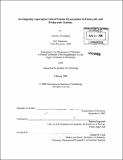| dc.contributor.advisor | Barbara Imperiali. | en_US |
| dc.contributor.author | Weerapana, Eranthie | en_US |
| dc.contributor.other | Massachusetts Institute of Technology. Dept. of Chemistry. | en_US |
| dc.date.accessioned | 2008-02-28T16:25:03Z | |
| dc.date.available | 2008-02-28T16:25:03Z | |
| dc.date.copyright | 2006 | en_US |
| dc.date.issued | 2006 | en_US |
| dc.identifier.uri | http://dspace.mit.edu/handle/1721.1/34495 | en_US |
| dc.identifier.uri | http://hdl.handle.net/1721.1/34495 | |
| dc.description | Thesis (Ph. D.)--Massachusetts Institute of Technology, Dept. of Chemistry, 2006. | en_US |
| dc.description | Vita. | en_US |
| dc.description | Includes bibliographical references. | en_US |
| dc.description.abstract | N-linked protein glycosylation is characterized by the formation of a -glycosylamine linkage to an asparagine residue within the Asn-Xaa-Ser/Thr consensus sequence. This modification is found in organisms from eukaryotic, archaeal and bacterial domains and is implicated in numerous cellular processes. Recently, a system of N-linked glycosylation was characterized in a gram-negative bacterium, Campylobacter jejuni. Glycosylation in this organism involves the transfer of a heptasaccharide from an undecaprenyl-pyrophosphate (Und-PP) carrier onto the asparagine side-chain of a protein. The genes in the 'pgl gene cluster' encode all of the proteins necessary for the biosynthesis of the glycan donor and its ultimate transfer to protein. The heptasaccharide donor has been characterized as GalNAc-al,4- GalNAc-al,4-(Glcpl1,3)-GalNAc-al,4-GalNAc-al,4-GalNAc-al,3-Bac-al ,PP-Und, where Bac is bacillosamine (2,4-diacetamido-2,4,6-trideoxyglucose). A synthetic route was developed to access bacillosamine-phosphate, which was incorporated into UDP-bacillosamine (UDP-Bac) and undecaprenyl-pyrophosphate-bacillosamine (Und-PP-Bac), which are substrates for the Pgl enzymes. Using the synthetic UDP-Bac, the role of the PglC glycophosphoryltransferase was elucidated in vitro. | en_US |
| dc.description.abstract | (cont.) The activities of the Pgl glycosyltransferases, PglA, PglJ, PglH and PglI were validated using the synthetic Und-PP-Bac substrate and it was discovered that PglH is a polymerase that catalyzes the transfer of the three terminal GalNAc residues. PglB is the oligosaccharyl transferase of the bacterial system. Using the synthetic glycan donor, PglB was shown to act in vitro on a short peptide substrate. This in vitro system enables detailed mechanistic investigations into the action of this intriguing enzyme. N-linked glycosylation in eukaryotes is catalyzed by oligosaccharyl transferase (OT), a multimeric protein complex localized in the lumen of the endoplasmic reticulum. The Stt3p protein of the eukaryotic OT cluster is homologous to the bacterial PglB enzyme. With the goal of inhibiting OT in a cellular environment, a family of peptidomimetic inhibitors with nanomolar affinity was synthesized. These inhibitors were evaluated for cellular inhibition of OT using a novel, high-throughput assay that monitors the production of a reporter glycoprotein, secreted alkaline phosphatase. The results from the screening yielded a hydrophobic peptidomimetic compound as a potential candidate for further studies into the in vivo inhibition of OT. | en_US |
| dc.description.statementofresponsibility | by Eranthie Weerapana. | en_US |
| dc.format.extent | 241 leaves | en_US |
| dc.language.iso | eng | en_US |
| dc.publisher | Massachusetts Institute of Technology | en_US |
| dc.rights | M.I.T. theses are protected by copyright. They may be viewed from this source for any purpose, but reproduction or distribution in any format is prohibited without written permission. See provided URL for inquiries about permission. | en_US |
| dc.rights.uri | http://dspace.mit.edu/handle/1721.1/34495 | en_US |
| dc.rights.uri | http://dspace.mit.edu/handle/1721.1/7582 | |
| dc.subject | Chemistry. | en_US |
| dc.title | Investigating asparagine-linked protein glycosylation in eukaryotic and prokaryotic systems | en_US |
| dc.type | Thesis | en_US |
| dc.description.degree | Ph.D. | en_US |
| dc.contributor.department | Massachusetts Institute of Technology. Department of Chemistry | |
| dc.identifier.oclc | 70851714 | en_US |
